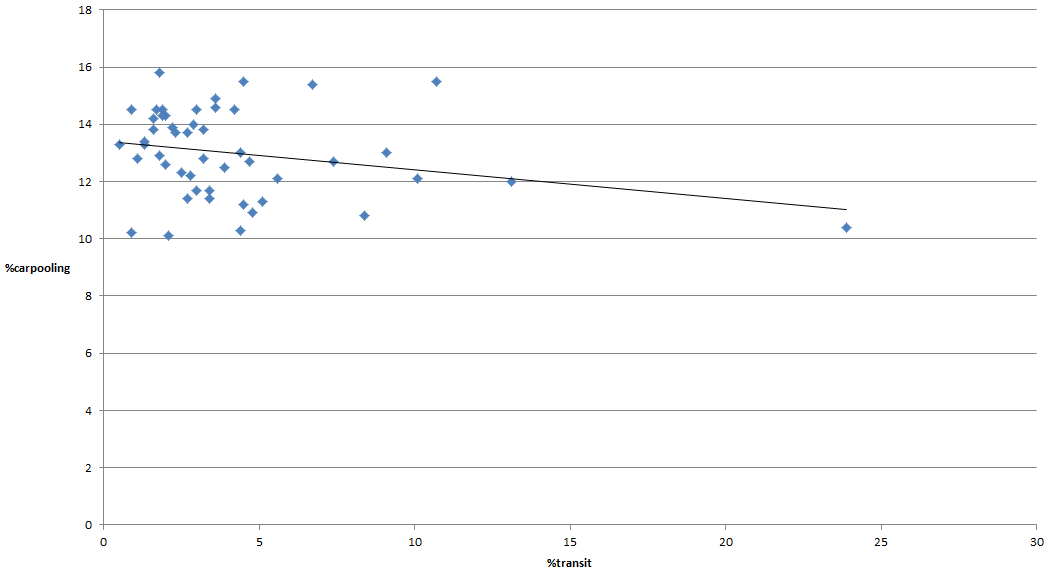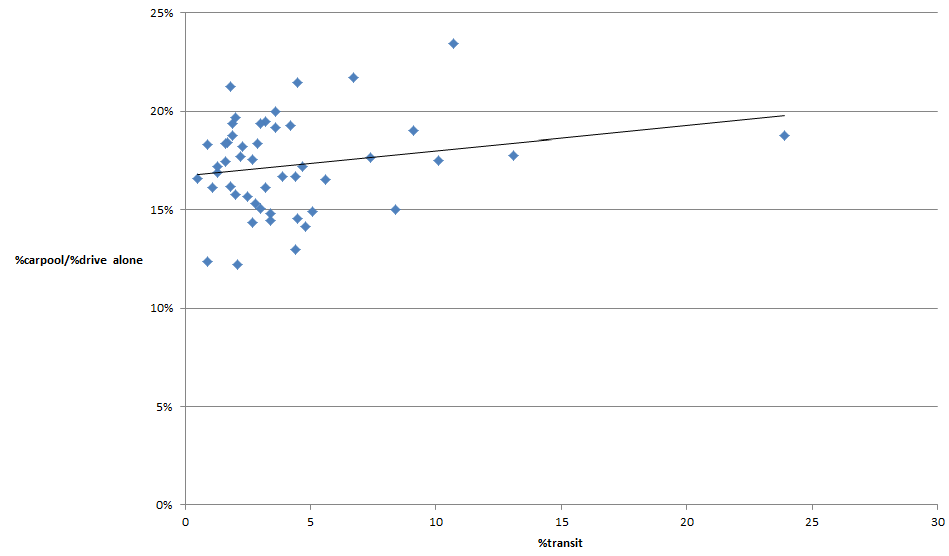And now, for the latest in our series of "things hardened motorists say make transit irrelevant so we shouldn't even bother investing in it": carpooling!
Carpooling is one of these ideas that, if you don't look at the details, sound positively magical in terms of efficiency. A private car has no deadheading and carpooling from a common origin to a common destination ensures a higher occupancy ratio than transit. Think about it, a bus can carry around 60 people, if it has on average 10 passengers, that is only on average 20% of capacity, the equivalent of a car with just the driver in. So with just one passenger, a car will have an higher average capacity utilization than a regular transit bus. Carpooling could also significantly increase throughput of existing roads. If every car carried 3 people instead of the 1,3 people they do at peak hour currently, then you could theoretically more than double the number of passengers per hour roads can carry.
On an economical level, some will point out that the cost per passenger-mile of cars driven alone is often equal or just slightly lower than transit (numbers that can be greatly debated). With just one passenger apart from the driver, the cost of car travel per passenger-mile becomes much less than transit's.
Furthermore, some point out that cities with low transit tend to have higher carpooling mode share for commutes:
 |
| Transit mode share vs carpooling mode share (source) |
So, argument over? We should just cancel transit investments and focus on incentivizing carpooling instead?
Yeah, not really.
Why carpooling is not a replacement for transit
Don't get me wrong, carpooling is a great idea if you can manage it in your schedule. However, carpooling is a very inflexible mode of transport for the passenger. Essentially, carpooling is like a bus line that has only two stops and that runs once in the morning in one direction and once in the evening in the other direction.
 |
| Schedule of a bus line versus "schedule" of a carpool, which do you prefer? (Yes, I use 24-hour time) |
So, in essence, all single occupancy car trips can be seen as potential carpooling lines, or even as some kind of express bus. In order for carpool to be a valid choice, you need:
A- To have the same origin and destination as another trip, or to be easily on the way
B- To need to leave in their morning at roughly the same time and to come back at roughly the same time too
Considering sprawl and the fact that arterials tend not to be residential (even worse for freeways), these two conditions are quite hard to fulfill. The time when they are most likely to be fulfilled is for the commute, as this is when the most trips are happening at the same time.
But wait, that's not all, with a bus line, if you miss one bus, you can take the next one, if you miss the carpool, you're screwed. If you want or have to stop somewhere while going to work or coming back home, it's hard to do it while carpooling, the passenger is captive of the schedule of the driver. Even worse for workers who have variable work schedules, which is more and more common. What if the driver has no overtime but the passenger has to stay at work 1 hour more to finish some task?
So it's no surprise that carpooling is largely fit only for a minority of people who happen to have very stable work schedules. Transit on the other hand has plenty of trips, allowing for much more freedom of movement.
So carpooling is not appropriate in most cases... at least it's still much more economical than transit, right?
Well... not exactly.
The big issue here is that, as I said, carpooling is not flexible at all, and commutes are just maybe 30% of people's trips. So if there is no transit in a car-dependent area, what does the passenger of a carpool do when he has to go somewhere else than at work? Well, in the end, he still has to own a car for when carpooling is unable to satisfy his mobility needs, which is most of the time. So carpooling doesn't eliminate the need for cars the vast majority of the time, and the basic fact about cars' costs is that fixed costs are very important, so not using your car doesn't cut down on costs all that much. Yeah, you save on gas and maintenance, and sometimes on parking and tolls, but the depreciation of the car is still there.
As I showed in a previous article, the cost per mile driven of a car varies greatly with the amount of miles driven, according to the AAA and CAA:
 |
| Cost in cents per mile per annual mileage, in blue the AAA, in red the CAA |
So let's take one example of a 3-people carpool versus a case where everyone drives alone. If everyone drives alone, then each car is driven 10 000 miles a year, at a cost of 0,80$ per mile. But if they carpool, then one car still drives the same amount of miles and costs the same, but the two others are driven over 30% less miles, with costs per mile driven increasing to 0,95$ per mile.
So, what happens to costs?
| ||
So overall, there is a cost reduction, but not as much as you'd think. Though miles driven are reduced by 20%, the total costs are reduced only by a little over 11% because of the fixed costs of ownership of the cars not used during the carpool.
Of course, you can make the argument that transit can also be the victim of this dynamic. However, as transit is a network with all-day service most of the time, the possibility of people to opt out of owning cars is much higher than with carpooling for the commute. And transit remains spatially more effective than cars even with carpooling. Even a bus with just 10 passengers occupy half as much road space as a car with 2 occupants. A bus that is full occupies nearly 6 times less road space than a car with 4 occupants.
So overall, transit can be a competitor to car ownership and travel the way carpooling can't really be.
Oh, and BTW, about carpooling declining with rising transit use, that is a mistake. Carpooling doesn't decline as a proportion of car trips as transit use increases, if carpooling has a lower mode share, it's just because CARS as a whole have a lower mode share.
 |
| Transit mode share versus the proportion of carpooling mode share over driving alone mode share |
Another fact that pops up when looking at the data is that congested cities don't necessarily have higher carpooling mode share. Which underlines that private vehicle occupancy is not impacted much, if at all, by congestion. In other words, you can't trust increased carpooling to deal with congestion.
What about slugging?
There is a final argument for carpool: slugging. Slugging means having people drive to a park-and-ride parking lot somewhere, park their cars there then get picked up by other people to do the rest as a carpool. Theoretically, it can help ease the problem of coordinating trips by moving the origin of the commute to a common parking lot rather than people's homes.
 |
| Traditional carpool, Blue goes from his home (Blue dot) to Red's home (Red dot) then both continue to a common destination |
 |
| Slugging: both Blue and Red head to a parking lot, where Red parks his car and continues with Blue to the destination |
This can help indeed to make more carpooling possible. But it may cause capacity problems near the parking lot due to the high number of vehicles going there and picking up people. But the biggest flaw of this approach is that if you have a park-and-ride parking lot... why not simply serve it with shuttles instead of relying mainly on carpooling? Just run a bus from the parking lot to the destination, then both Blue and Red can leave their cars there and board a shuttle bus. This kind of express bus is very economical as they have few stops and tend to have higher occupancy, the AMT runs express buses for less than 0,30$ per passenger-mile in Montréal. This also reduces even more the need for parking and road capacity in areas with high job density.
Conclusion
So, what of carpooling? It certainly beats driving alone, so if you are one of the lucky ones that can use it, please do, and favoring people who carpool with HOV lanes is very defensible. However, carpooling alone doesn't solve the issue of carless mobility and its economic benefits are overestimated by neglecting the fact that carpool passengers still largely need to own cars on the side. If anything, transit may be complementary to good carpooling option as it gives a fallback to passengers if their ride doesn't show up.

Of course, sometimes carpooling is actually sufficiently useful (say, if everyone works at the same navy base) that it gets more and more organized until the driver is actually driving a city bus and getting paid by the transit company. Kitsap Transit's Worker/Driver program is an interesting example that's kind of a hybrid of carpools and transit.
ReplyDeleteOr, better yet, the shuttles organized by certain employers to pick up workers, a bit like school buses. Like the Google shuttles, which can be seen as a form of carpooling provided by the employer.
DeleteI wouldn't necessarily say it's better. Anyone can take any Kitsap Transit bus, so if this carpool happens to be going your way, you can ride it. Employee shuttles are only for employees. True story: I was interviewing at a tech company in the Bay Area and had to have a friend give me a ride, because while they had a shuttle from the Caltrain station, I wasn't allowed to use it.
DeleteThis comment has been removed by the author.
ReplyDeleteThis comment has been removed by a blog administrator.
ReplyDelete